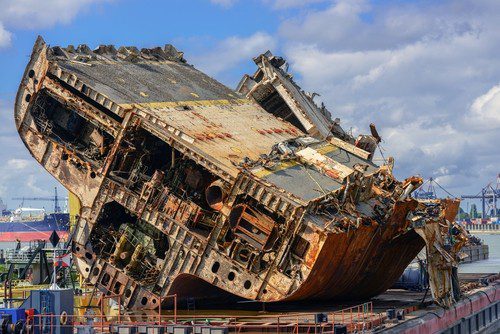Ship Recycling. Basically just an expression. Quite amazing though how much content there is behind these two words, notes Mrs. Jessica Röttmer, Ship Recycling Engineer, GSR Services.
Responsible ship recycling in a sense of environmental, social and corporate governance (ESG) includes planning, organizing and documenting, to mention some of the tasks involved only generically. Leaving the generic level, a bit of a closer look is now being taken at the respective contents.
Legal compliance is of utmost importance. Due to a rather complicated legislative landscape in ship recycling, the risk of taking decisions leading to severe consequences is eminent. Varying requirements of Basel Convention, Basel Ban Amendment -for quite a few also EU Ship Recycling Regulation plus various local legislations need to be dealt with.
The decision to recycle a ship and simultaneously ship’s position and trading route create a changing legal landscape which must be obeyed throughout the planning process. This influences available ship recycling and shortening the last voyage by finding nearby recycling options contributes to environmental goals such as emissions reduction as well.
With compliance issues clarified, a rough selection of ship recycling yards can be initiated. Selection criteria are i.e. size, capacity, location, method etc.
Following this first selection, a tendering process requesting some detailed information from respective yards will help narrowing down the number of yards for the following selection procedure.
Due diligence inspections of ship recycling facilities are an essential part of the selection process for identifying a suitable and capable ship recycling yard. Verification of all compliance aspects including preventive measures, social aspects, infrastructure and much more should be part of the audit. Comparing audit results by prioritization of defined criteria helps benchmarking the options within the limits.
Having decided on a ship recycling yard, contractual matters need to be dealt with. Specific clauses for ensuring clear technical requirements, milestones, seller’s rights and enforcement options should be considered.
Enabling a ship recycling facility to draw up a plan for the recycling of a specific ship, especially in regards to any possible hazards, proper documentation needs to be handed to the ship recycler. The Inventory of Hazardous Materials (IHM0 is containing details about hazardous materials onboard a vessel and as such provides crucial information for health, safety and environmental aspects during ship recycling. Ships above 500GT calling at EU ports have to have a certified and maintained “Inventory of Hazardous Materials – Part I” throughout their operational life already.
The IHM Part I lists hazardous materials contained in structure and equipment of a ship. Relocations, removals and new installations need to be documented, that is IHM-maintenance for which the owner is responsible. A task for the entire life of a ship. Ordered products if IHM relevant need to be accompanied by Material Declarations (MD) and a Suppliers Declaration of Conformity (SDoC) issued by the supplier. If a hazardous materials is contained, the product needs to be tracked onboard and documented.
Coming closer to the ship’s final destination, planning for the last voyage including activities like preparation of IHM Parts II and III (hazardous materials in stores and as wastes on-board), disposal of cargo residues and further activities in line with requirements and contractual arrangements need to be done. Respective information is important for the ship recycler to be clear on these aspects.
Last but not least, for ensuring that all efforts undertaken up to this stage are being finalized successfully, a “ready for recycling certificate” can be issued by various classification societies. After delivery supervision during recycling activities and reporting on the same including incidents and accidents is a further essential cornerstone. Continuous compliance by the SRF should be verified during ongoing recycling works. The supervisors can be last owners´ staff or external service suppliers and should be similarly carefully chosen. ESG compliance verified by independent third-party professionals prevents conflict of interest and takes best care of responsibilities including creation of unbiased evidence.
In an essence, key steps for responsible and sensible ship recycling can be summarized to
Conceivably, there’s a lot more content to each of these steps than what could be conveyed in an article. Profound knowledge and expertise on the details is required for successfully driving a responsible and sustainable ship recycling strategy. Most decision makers are less familiar with this topic than with shipbuilding and proper advice is inevitable.
The views presented are only those of the author and do not necessarily reflect those of SAFETY4SEA and are for information sharing and discussion purposes only.





